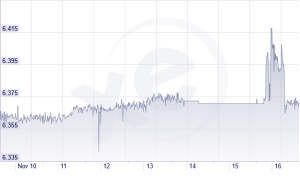The Federal Reserve may not like this. Donald Trump and his supporters will definitely hate this.
Experts from the International Monetary Fund (IMF) say that China’s yuan renminbi should be included in its reserve currencies, a suggestion being welcomed by Chinese authorities.
It could mean that the yuan will now be formally introduced into the IMF’s special drawing rights (SDR) currency basket at the end of the year. This would be a historic move for both the global economy and the nation of China, which has been drawing ever so closer to being a major economic power. The world’s second-largest economy has been urging the IMF for more than a year to include the yuan into the SDR currencies.
Christine Lagarde, head of the IMF, explained that the fund now “meets the requirements to be a ‘freely usable’ currency.” The IMF argued that the yuan had been too controlled by the People’s Bank of China (PBOC), and thus had been impossible to complement the greenback, yen, euro and pound in international trade.
Lagarde added that this could generate greater stability in the global economy.
Despite the PBOC devaluing its currency this past summer that sent shockwaves through stock markets, the PBOC believes it will garner “win-win benefits for both China and the world.”
What does this mean all of the parties mentioned? Here is what the Wall Street Journal opines:
For China, the IMF’s inclusion of the yuan as a member of its lending reserves is more than just political and economic prestige. It has also been part of its strategy to elevate Beijing’s role in the international economy at a time when the Asian powerhouse is trying to challenge U.S. political and economic dominance around the world.
China has been steadily broadening the international use of the yuan. The amount of trade settled in Chinese currency has more than doubled over the last several years to more than $1 trillion annually. It has set up dozens of yuan-denominated short-term credit lines called swaps with central banks around the globe totaling $3 trillion.
While U.S. officials still privately question the yuan’s ripeness for reserve-currency status, they also see China’s bid as aiding efforts by reformers within the People’s Bank of China to liberalize the country’s economy. With their eye on the IMF’s designation, Chinese officials have accelerated their efforts to overhaul the financial sector over the past year. That included an August devaluation authorities say was intended to make the yuan more market-determined and opening up its debt markets to central banks.
One would think that the yuan receiving the backing of the IMF would cause the RMB to soar. However, this has yet to happen as the currency fell to an intra-day low of 6.379 per U.S. dollar Monday. This is lower than the PBOC’s midpoint rate of 6.375 and Friday’s 6.374. Ostensibly, the news didn’t generate enough buzz or buying interest.
Chart courtesy of XE.com:
Whatever the case, it’s quite apparent that the dollar’s days as the top dog is gradually coming to an end.

Leave a Comment